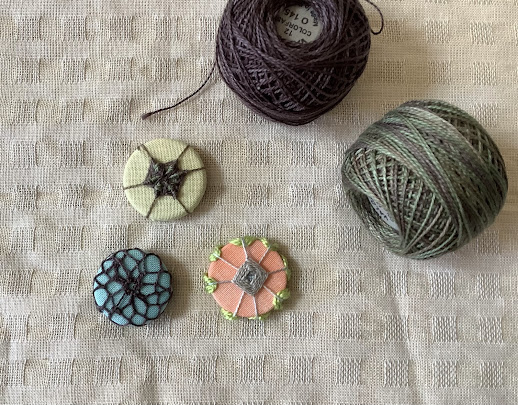The internet diminishes the distance between needleworkers for sharing ideas and techniques. From my kitchen table, I joined a group of UK stitchers and embroiderers this weekend for a Zoom workshop on making needlework covered buttons.
 |
| Needlework covered buttons from a recent workshop with Gina Barrett. |
The two-hour workshop, called “Curiously Wrought: Making Needlework Buttons with Gina Barrett,” was sponsored by the Embroiderers’ Guild in the UK. Gina Barrett, the workshop’s instructor, is an author, illustrator, entrepreneur, and maker. She brings her passion for period costumes and historical passementerie to her workshops and her extensive experience in the craft is evident in her ease and skill of presenting and teaching these historical button-making techniques.
Stitching commonalities
Although there is a distinction between “embroidered” buttons and “needlework” buttons, Gina explained, if you are an embroiderer or hand stitcher, you’ll find many that of the stitches used in making needlework buttons seem familiar. Several workshop participants sited using the stitches in other textile disciplines—although were called by a slightly different name. In this workshop, we used the basic the rounded back stitch, blanket stitch, and a spiderweb stitch for our class buttons.
 |
| Supplies for making needlework covered buttons. |
Button-making supplies are probably already in your stash
The supplies needed for this technique are minimal and comprised of items that most needleworkers and stitchers have on hand—perle cotton thread, small fabric scraps, buttons, needles and scissors. Workshop participants learned three button designs. Compared with historical buttons that were made in the 16th, 17th and 18th centuries, today’s needleworkers have myriad threads, fibers, colors, and thread weights available in the market to provide endless possibilities for creativity and developing unique designs. Gina was very encouraging and supportive of experimenting with any of them.
Finding your rhythm
As one would expect with any new skill, continued practice will provide more consistent results. Gina indicated that once you find a good stitching rhythm, balanced thread tension usually follows—providing more desired results.
This workshop was a wonderful experience and the buttons were fun to make! My first attempts need more finessing (obviously—by the photos), but now that I have a general understanding of the basics for making needlework covered buttons, I’ll be applying more effort and practice into achieving finer results.
I’m adding needlework buttons—another small, portable project—to my travel bag repertoire.







.jpg)

